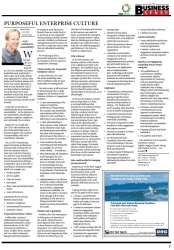David White:CEO DRG Outsourcing - Purposeful Entreprise Culture2016-12-02 A pre-condition for sustainability?
When last did you, in your busy life as CEO or as member of a senior leadership team, push back to reflect upon what really defines your organisation’s culture; what makes your business unique and drives your team’s approach to work in your business? And, if you had reached a conclusion, would the majority of team members concur that, that such a conclusion is indeed their everyday experience of their world of work? Corporate Governance is fundamentally about enterprise sustainability â€" in the interests of key stakeholders: shareholders, customers, suppliers, employees and, ultimately, the economy. Being CEO is a tough job! The CEO’s effectiveness and that of the leadership team, is measured against the yardstick of sustainability, with all its contributory elements. We, at DRG Outsourcing, regard enterprise performance measurement as being derived from two primary sources: How your customer measures you and how your shareholder measures you? The sustainability of such measurement findings is dependent upon a diversity of contributory elements amongst which, for example, are:
Deliberately conceived, implemented and rigorously maintained enterprise culture frameworks are, in the DRG Outsourcing experience, a rarity. Despite vision, mission and ‘our values’ statements being prominently displayed in reception areas and notice boards, these are rarely lived by or practiced as non-negotiable norms guiding everyday business activities. Similarly, performance management practices tend to be an event, a corporate ritual, rather than an embedded leadership practice. We would argue that a purposeful enterprise culture is an essential tool in the quest for competitive advantage. Characteristics of a Purposeful Enterprise Culture It starts with the CEO and the senior leadership team, where emphasis is placed upon leadership, not management The entire team, at all levels and in all functional areas, is fully engaged in the business of the business. Evidence of engagement includes:
Mergers and Acquisitions Nowhere does the consequence of delinquency in attention to the culture element become more apparent than when two or more business entities are integrated. It is a well-researched and documented phenomenon that most such integrations either fall short in delivering to the outcomes of synergies put forward in the business case made for them, or diminish the enterprise value of merged entities. Rather than the blending process that it should be, the reality becomes a toxic mix of conflicting agendas and behaviour! The focus on results is compromised. Why is this so? In the first instance, the business cultures of the entities to be combined are likely to be divergent. The feasibility study or, due diligence process justifying the integration tends to focus upon aspects such as financial synergies, product line or service offering expansion, optimisation of assets, geographic location and similar arguments; with the role that the human capital element plays in the process, as an afterthought. In the second instance, human nature being what it is, there is a strong likelihood that perceptions of a dominant versus a subservient partner come into play: a winner and a loser; influencing the behaviour of what should have become a fresh, new and energised team. Egos rather than rationality play a role. There will be role confusion, scores to settle, points scoring, resistance to change, ‘told you so’ moments when avoidable unintended outcomes become apparent and so on. Rival parties will dance around each other rather than engage. Previously effective entities dissolve into a dysfunctional culture detracting from focus on the customer and shareholder expectations. How could an effective merging process proceed? Experiences ‘in the field’ suggest that the implementation process be informed by both a wellconceived (with the objective of the integration always as a guiding principle) and a wellplanned, deliberate process, for example: Getting the base right (know and fix the gaps from the start):
Implement
Results! ï® DRG Outsourcing (Pty) Ltd Tel: +27 (0) 31 - 767 0625 Fax: +27 (0) 31 - 767 3280 david@drg.co.za www.drg.co.za |
David White:CEO DRG Outsourcing - Purposeful Entreprise Culture
Copyright © 2024 KwaZulu-Natal Top Business
